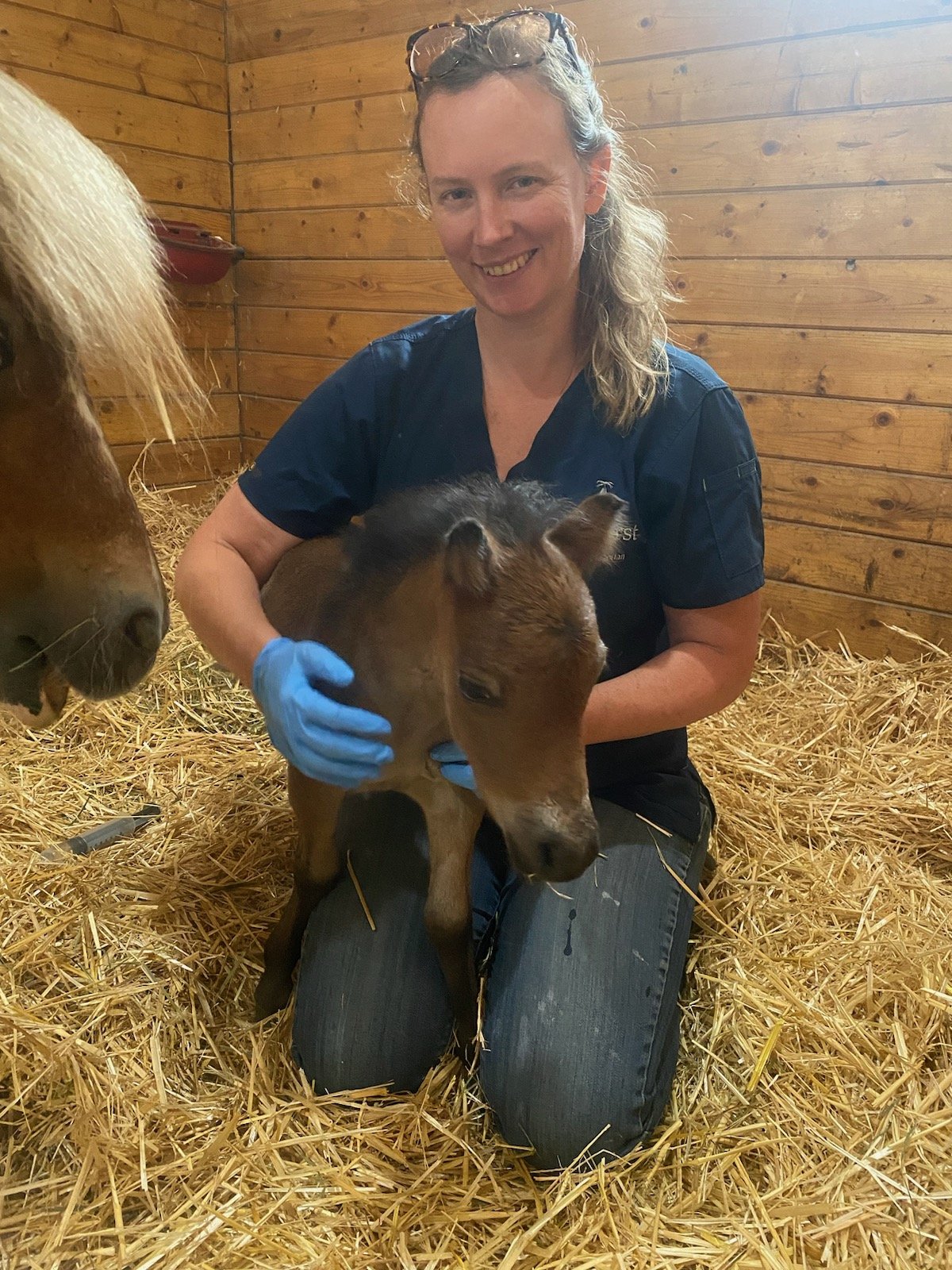Equine internal medicine encompasses the specialized veterinary care focused on diagnosing, treating, and managing a wide range of diseases and disorders affecting horses. Focusing on non-surgical aspects of equine health, this field covers areas such as infectious diseases, respiratory disorders, gastrointestinal issues, cardiology, neurology, endocrinology, dermatology and more. At Oakhurst our veterinarians will utilize diagnostic tools such as imaging, blood tests, and endoscopy to diagnose these conditions and employ treatments such as medications, dietary adjustments, and potential surgical intervention recommendations to manage and improve the health of horses. Additionally, preventive measures including vaccination protocols, parasite control, and nutritional management are essential components of equine internal medicine to ensure the overall well-being and performance of horses.
Equine Respiratory Disease
Horses are indeed prone to various respiratory issues, which can arise from infections or environmental factors. A comprehensive respiratory workup for horses may involve several diagnostic procedures to assess their condition thoroughly. Here are some common techniques that can be employed in respiratory evaluations:
Auscultation: This involves using a stethoscope to listen to the sounds produced by the lungs and airways during breathing. Abnormal lung sounds can indicate respiratory problems.
Rebreathing Bag: A rebreathing bag is a specialized device that allows the horse to inhale a higher concentration of carbon dioxide. This can help identify respiratory abnormalities or airway obstructions.
Ultrasound: Ultrasound imaging can be used to visualize the respiratory system, including the lungs and pleural space. It can assist in detecting abnormalities such as masses, fluid accumulation, or structural changes.
Radiography: X-rays (radiographs) of the chest can provide detailed images of the lungs and airways. They help identify conditions like pneumonia, tumors, or obstructions.
Endoscopy: An endoscope is a flexible tube with a camera that can be inserted into the respiratory tract. It allows visualization of the upper pharynx, larynx, trachea, and bronchi. This procedure helps diagnose conditions like laryngeal paralysis, tracheal collapse, or inflammatory airway disease.
Tracheal Wash and Bronchoalveolar Lavage (BAL): These techniques involve collecting samples of lung fluid to analyze cellular composition and check for the presence of infectious agents. Cytology examines the types of cells present, while culture helps identify specific pathogens responsible for respiratory infections.
These diagnostic tools are valuable for differentiating between infectious causes, inflammatory airway diseases, and allergic airway diseases. They aid veterinarians in formulating appropriate treatment plans and managing respiratory conditions in horses effectively.
Equine Neonatal Care and New Foal Exams
Equine neonatal care and new foal exams play a crucial role in ensuring the well-being of foals and setting them up for a healthy future.
Foal IgG Levels Assessment: Performed within the first 24-48 hours to assess the foal’s passive transfer of immunity from the colostrum. Adequate levels of immunoglobulin G (IgG) ensure the foal's immune system is adequately protected against diseases. Low IgG levels can indicate failure of passive transfer (FPT) and may require additional interventions such as plasma transfusion to boost the foal's immunity.
General Health Assessment: The veterinarian will assess the overall health of the foal, checking for any visible abnormalities, signs of distress, or congenital conditions. They will evaluate the foal's vital signs, including heart rate, respiratory rate, and body temperature.
Umbilical Examination: The umbilical cord stump is inspected for any signs of infection or abnormalities. Proper care and cleaning of the umbilicus are essential to prevent infections that can lead to serious complications.
Joint Evaluation: The veterinarian will examine the foal's joints for any signs of swelling, heat, or pain. Joint abnormalities can be a cause for concern and may require further investigation or treatment.
Congenital Defects: The foal will be checked for any congenital defects or abnormalities that may impact its health or future performance. Common issues include limb deformities, cleft palate, heart murmurs, or hernias.
Nutrition and Passive Transfer of Immunity: The veterinarian will evaluate the foal's nursing ability and assess whether it is receiving adequate colostrum, which provides essential antibodies for immune system development. They may also provide guidance on proper nutrition and supplementation if needed.
Vaccinations: Depending on the foal's age and the region's specific requirements, the veterinarian may administer initial vaccinations or discuss a vaccination plan to protect against common equine diseases.
Parasite Control: The vet may discuss an appropriate deworming schedule to protect the foal from internal parasites. Maintaining good parasite control is important for the foal's overall health and growth.
Overall, neonatal care for a foal requires careful attention to detail and prompt veterinary intervention when needed. Early and proactive management can significantly contribute to the foal’s health and future well-being.
Equine ophthalmology
A comprehensive ophthalmologic examination involves several steps to assess the health of the eyes and diagnose any potential issues. Here is an overview of the process and additional diagnostic techniques that can be utilized by a veterinarian:
Examination at rest: The initial step involves observing the head and face for any noticeable abnormalities or asymmetry that may indicate underlying eye conditions.
Fundic examination: To evaluate the back of the eye, a direct ophthalmoscope is used. This handheld instrument allows the veterinarian to visualize the retina, optic disc, blood vessels, and other structures within the eye.
Subpalpebral lavage system: In cases where eye infections are difficult to treat or when dealing with uncooperative patients, a subpalpebral lavage system can be utilized. This system involves placing a catheter in the eye, which is then connected to the mane. Medications can be administered through this system without direct contact with the eye, providing a more convenient and less invasive method.
Tonovet for intraocular pressure (IOP) measurement: Measuring IOP is essential for diagnosing conditions such as anterior uveitis or glaucoma and monitoring disease progression. The Tonovet is a specialized device used to measure IOP in animals. It provides a quick and accurate assessment of the pressure inside the eye.
Additional diagnostics: Other diagnostic techniques that may be employed include ocular staining, nasolacrimal duct cannulation, ultrasound, and radiographs. Ocular staining helps detect corneal ulcers or foreign bodies. Nasolacrimal duct cannulation involves flushing the tear duct to check for blockages. Ultrasound and radiographs may be used to evaluate the eye's internal structures, particularly in more complex cases.
Collaboration with Ophthalmologists: If necessary, the clinic may collaborate with local board-certified ophthalmologists for specialized consultations. This ensures that patients receive the most comprehensive and expert care available.
By employing these diagnostic techniques and collaborating with specialists when needed, Oakhurst veterinarians aim to provide thorough evaluations and effective treatment for various eye conditions in horses.
Equine Endocrine Disease
Pituitary Pars Intermedia Dysfunction (PPID) also known as Cushing’s disease, and Insulin Dysregulation (previously named Insulin Resistance or Equine Metabolic syndrome), are prevalent endocrine disorders commonly observed in middle-aged to older horses. If left untreated, these conditions can result in severe health problems, such as laminitis and impaired wound healing. Utilizing routine bloodwork is vital in the early detection and management of these disorders.
Routine bloodwork serves as a valuable tool in identifying and addressing these conditions at an early stage, thus preventing potential complications. To diagnose PPID, specific blood tests are conducted, typically including the measurement of adrenocorticotropic hormone (ACTH) levels. Treatment generally involves administering medication to regulate hormone levels and improve the overall well-being of the horse.
In the case of Insulin Dysregulation, blood tests are performed to evaluate glucose and insulin levels, along with other metabolic parameters. Management plans often involve dietary adjustments such as controlled grazing and implementing a low-starch, low-sugar diet, combined with regular exercise. Medications may be prescribed to assist in regulating insulin.
Through the prompt identification and management of these endocrine disorders via routine bloodwork and appropriate treatments, horse owners and veterinarians can effectively minimize the risk of complications and promote the overall health and well-being of affected animals.
Equine Cardiology
At Oakhurst Equine we are proud to offer a comprehensive cardiac evaluation service specifically designed for horses exhibiting exercise intolerance, murmurs, or arrhythmias. Our services include ECG, murmur evaluation, and cardiac echocardiogram (ultrasound) of the heart. Through these advanced diagnostic techniques, we aim to unravel the complexities of equine cardiovascular health, enabling us to develop tailored treatment plans and optimize the well-being of our equine patients. We prioritize open communication, ensuring that horse owners and referring veterinarians receive detailed reports and have the opportunity to engage in discussions regarding their horse's cardiac health. By staying at the forefront of research and fostering collaborations with other specialists, we continuously strive to enhance our expertise and provide the highest standard of care for horses in need of cardiac evaluation.









